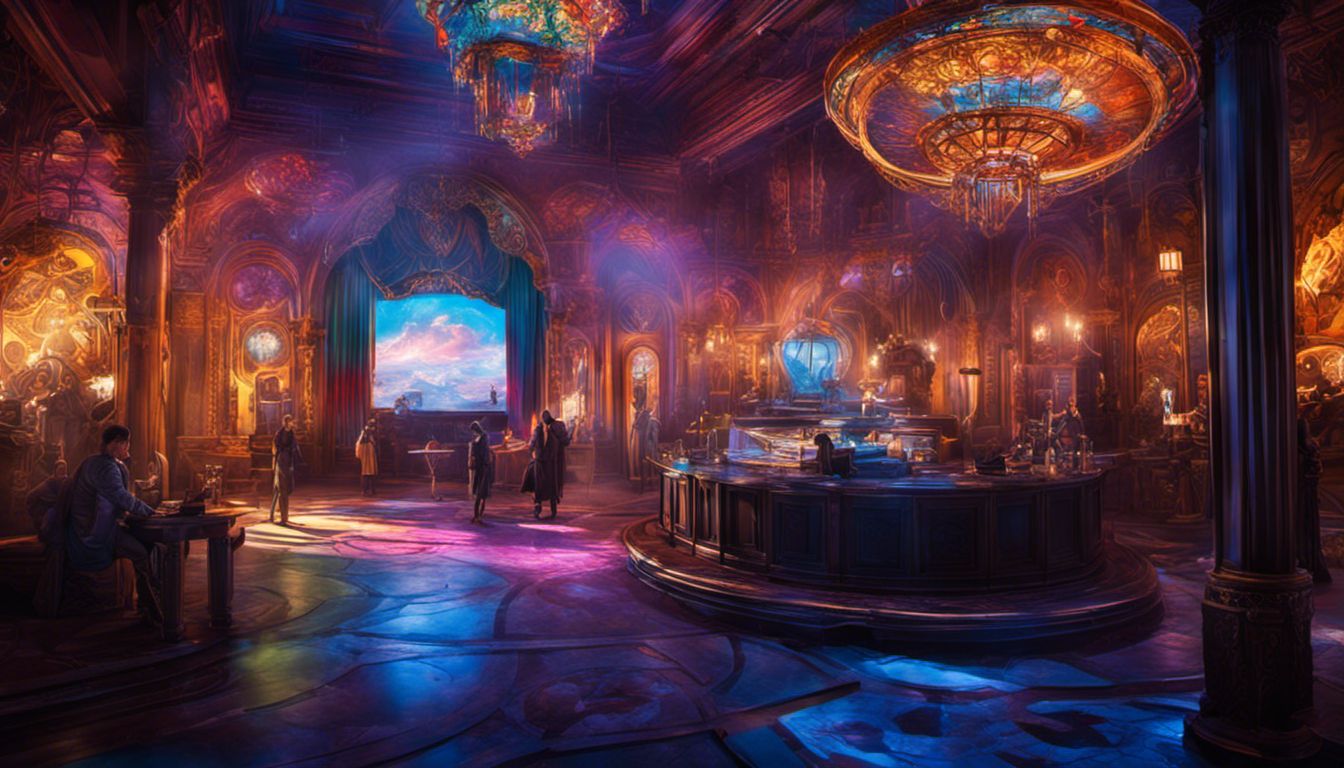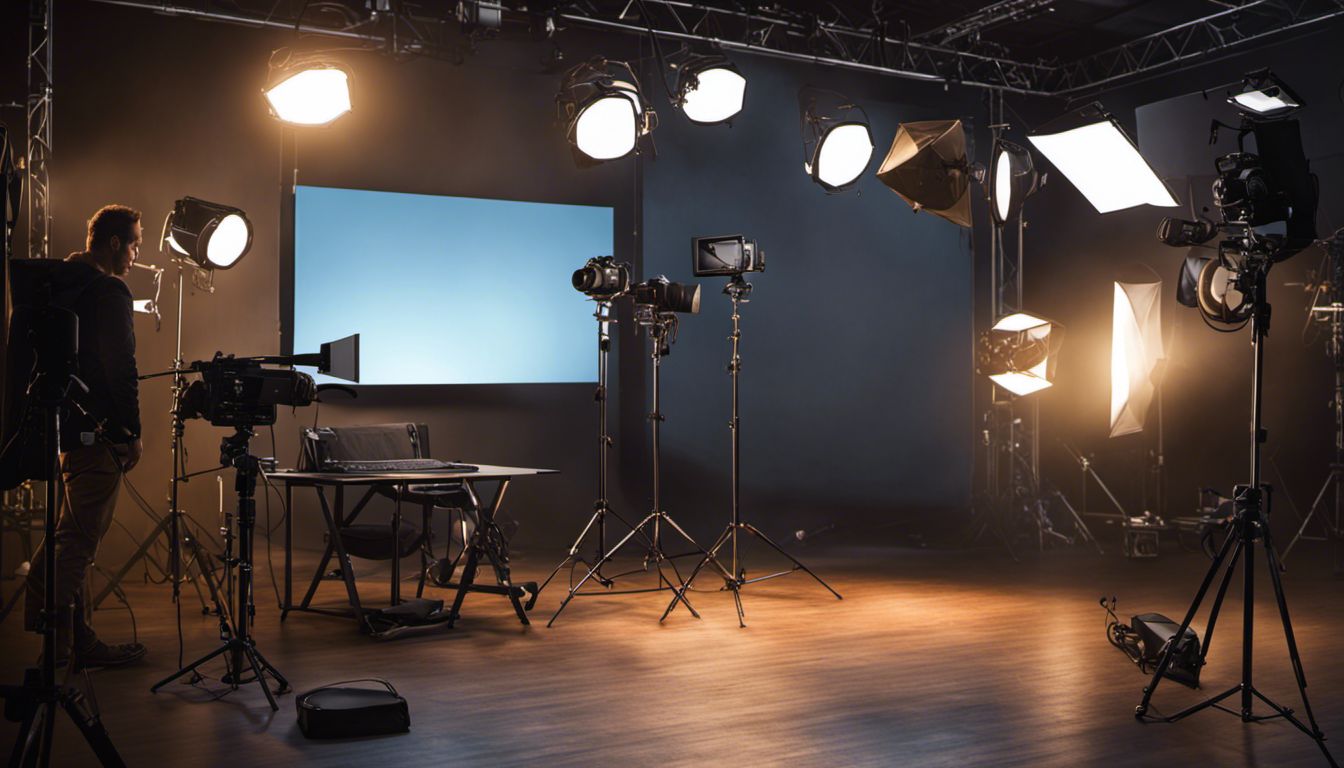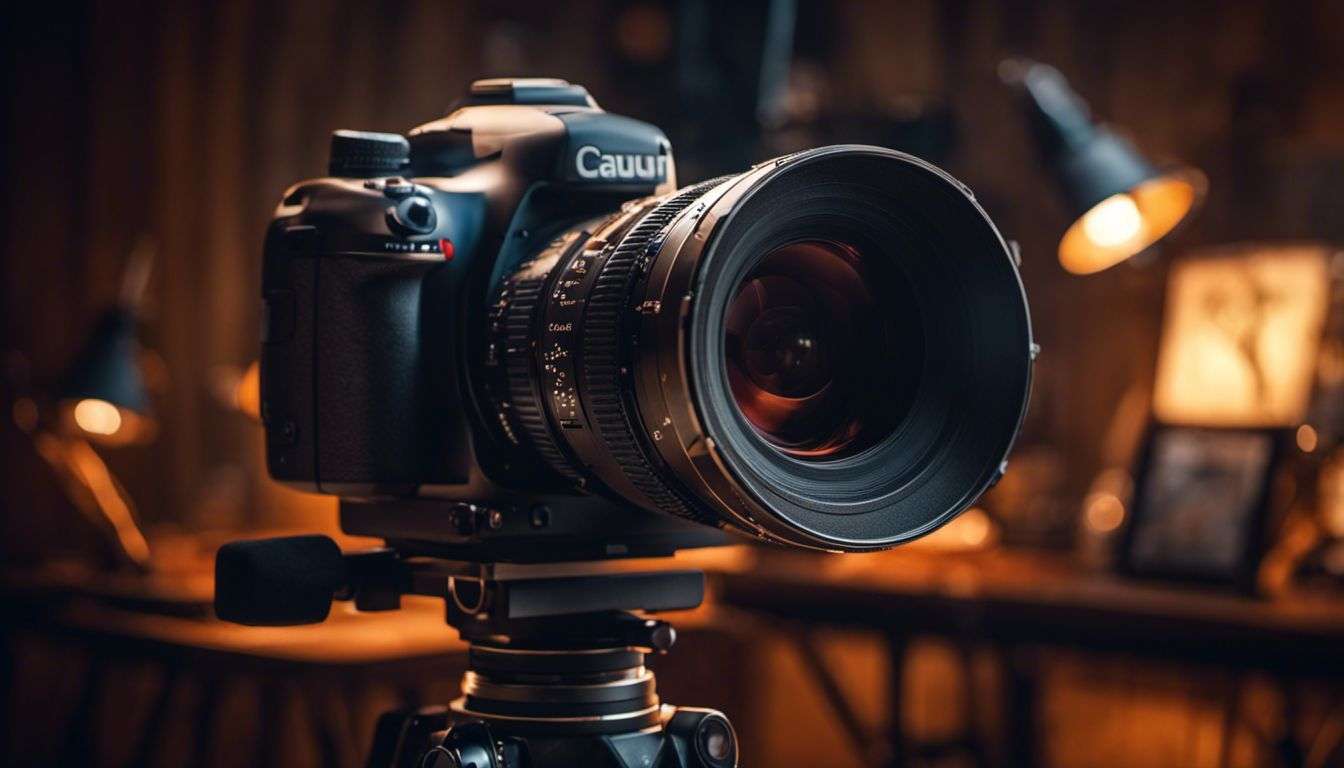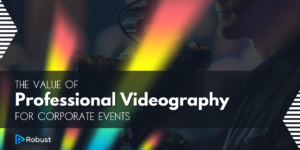Struggling to capture that perfect shot? The secret lies in excellent videography lighting. This blog post explores the crucial role of different lighting equipment in enhancing your film’s quality and visual appeal.
Journey with us as we guide you through choosing and using the right gear, illuminating your way to superior videography!
Key Takeaways
- Tungsten lights are cost – effective options that provide high color accuracy, making them ideal for scenes set during dawn or dusk.
- HMI lights offer powerful daylight – balanced illumination and are favored for their longevity and consistent performance over time.
- Fluorescent lights are energy – efficient, produce soft diffused lighting, and have the option to adjust color temperature for maximum creative control.
- LED lights are popular due to their energy efficiency, long lifespan, adjustable color temperatures, compact size, and portability.
Types of Production Lighting for Filmmakers

Filmmakers have a variety of production lighting options to choose from, including tungsten lights, HMI lights, fluorescent lights, and LED lights.
Tungsten Lights
Tungsten lights, often referred to as ‘hot lights’, have been a staple in film production lighting for many years. They emit a warm, orange hue that closely mimics the natural glow of the setting sun.
This makes them an ideal choice for scenes set during dawn or dusk. Despite their heat output, filmmakers continue to use tungsten lights due to their high color rendering index (CRI), which provides superior accuracy in showcasing colors.
However, they do require careful handling due to their extreme heat and delicate filament construction. One advantage is that these standard fixtures are cost-effective and easy-to-find replacements for damaged bulbs compared with some modern light types.
HMI Lights
HMI lights stand among the most effective tools in a videographer’s kit. Known for their high light output and color temperature similar to daylight, they play a crucial role in film and video production lighting.
HMI (Hydrargyrum Medium-Arc Iodide) illuminates scenes in vibrant detail, providing an ideal solution for outdoor shoots or situations demanding powerful lighting.
As highly efficient sources of bright white light, HMI lights outshine other types of video production lighting such as tungsten or fluorescent lights. They consume less power while maintaining an impressive brightness level.
Filmmakers favor these particular kinds of lights for their longevity and consistent performance over time.
Fluorescent Lights
Fluorescent lights make an outstanding choice for videography lighting due to their high energy efficiency and low heat output. Their greenish-blue hue can offer a more natural, real-world look in your films or videos.
Some models even allow you to change the color temperature for maximum creative control. Fluorescent lights provide a soft, diffused illumination that eliminates harsh shadows, making them perfect for interview setups or studio shoots where you want to flatter your subject.
Due to their durability and long life expectancy, they are also cost-effective in the long run for continuous video productions or extensive shooting schedules. They come in various shapes and sizes, which allows flexibility when designing your lighting setup for video shoots.
LED Lights
LED lights have become increasingly popular in the world of videography due to their many advantages. LED stands for Light Emitting Diode, and these lights are known for their energy efficiency and long lifespan.
They produce very little heat, making them safe to use during long shoots. LED lights also offer a wide range of color temperatures, allowing you to easily adjust the lighting to match your desired look.
With their compact size and portability, LED lights are a versatile choice for videographers looking for reliable and flexible lighting options.
Latest Innovations in Production Lighting Technology

Production lighting technology has advanced significantly with innovations such as self-cleaning systems and adjustable color temperature, making it easier than ever to achieve the perfect lighting for your videography needs.
Keep reading to discover the latest advancements in production lighting that can take your videos to the next level.
Self-cleaning systems
Self-cleaning systems are among the latest innovations in production lighting technology that can make a filmmaker’s life easier. With self-cleaning systems, you no longer have to worry about dust and dirt accumulating on your lights, which can affect their performance and brightness.
These systems use special mechanisms or coatings that repel dirt and keep your lights clean with minimal effort. This means less time spent on cleaning and more time focusing on your creative vision.
Self-cleaning systems are a valuable feature to look for when choosing lighting equipment for videography.
Another advantage of self-cleaning systems is that they help extend the lifespan of your lights. By preventing dust build-up, these systems reduce the risk of overheating and damage to internal components.
Adjustable color temperature
Adjustable color temperature is a crucial feature to consider when choosing lighting equipment for videography. This innovative technology allows you to customize the color of the light emitted by your lights, giving you more control over the look and feel of your videos.
Whether you want warm, yellowish tones or cool, bluish tones, adjustable color temperature lets you easily achieve the desired effect. With this feature, you can adapt to different shooting conditions and create the perfect ambiance for your videos without having to invest in multiple sets of lights with fixed color temperatures.
It’s a versatile tool that adds depth and dimension to your footage while enhancing visual storytelling.
Smartphone control
Controlling your lighting setup has become easier than ever with the latest innovations in production lighting technology. One of the most convenient features is smartphone control, allowing you to adjust your lights remotely using a dedicated app.
With just a few taps on your phone screen, you can change the brightness, color temperature, and even create custom lighting presets for different scenes. This feature provides flexibility and convenience for videographers who want to have full control over their lighting without being tied down to physical controls or complex settings.
Choosing the Right Lighting Kit
To choose the right lighting kit, consider your needs and budget, determine the type of lights you need, look for additional features, and read reviews and compare brands.
Consider your needs and budget
To choose the right lighting kit for your videography needs, it’s important to consider both your specific requirements and your budget. Think about the type of projects you typically work on and what kind of lighting will best suit those situations.
Additionally, think about how much you’re willing to spend on equipment. Setting a budget can help narrow down your options and ensure that you’re making an investment that makes sense for you.
By considering your needs and budget together, you can find the perfect lighting kit that meets both your creative goals and financial constraints.
Determine the type of lights you need
To choose the right lighting kit for your videography needs, it’s essential to determine the type of lights you require. Consider factors such as the shooting location, subject matter, and desired atmosphere.
There are various options available like tungsten lights for warm tones and high color accuracy, HMI lights for powerful daylight-balanced illumination, fluorescent lights for energy efficiency and soft lighting, or LED lights for versatility and portability.
Assess your specific requirements to select the most suitable lighting equipment that will enhance your video production.
Look for additional features
When choosing the right lighting kit for your videography needs, it’s important to look for additional features that can enhance your filming experience. Some lighting kits come with adjustable color temperature settings, allowing you to create different moods and atmospheres in your videos.
Other kits may offer smartphone control capabilities, giving you the convenience of adjusting lights remotely. Additionally, some lighting equipment may have self-cleaning systems which help keep them in optimal condition.
Considering these extra features can help you make an informed decision and find a lighting kit that best suits your needs as a videographer.
Read reviews and compare brands
To make an informed decision about which lighting kit to purchase, it is essential to read reviews and compare brands. By reading reviews from other videographers or filmmakers, you can gain valuable insights into the performance, durability, and overall quality of different lighting equipment options on the market.
Comparing brands allows you to evaluate factors such as reputation, customer support, and pricing. Take the time to research and explore various reviews and brand comparisons before investing in a lighting kit for your videography needs.
Essential Lighting Equipment for Videography
Ring lights provide a soft and even light source for capturing professional-looking videos.
Ring lights
Ring lights are a popular choice among videographers for their unique circular shape and soft, even lighting. These lights consist of a ring-shaped light fixture with built-in LEDs or fluorescent bulbs.
They are commonly used in portrait photography and close-up video shots to achieve a flattering, shadow-free lighting effect on the subject’s face. Ring lights are also practical because they can be mounted directly onto the camera, providing convenient on-camera illumination.
With their compact size and lightweight design, ring lights are a versatile tool that can easily be transported and used for various videography projects.
Softbox lights
Softbox lights are a popular choice among videographers due to their ability to produce soft, diffused lighting. These lights consist of a fabric cover that attaches to a metal frame, enclosing the light source and creating a larger area of illumination.
The result is even, flattering light that minimizes harsh shadows and reduces glare. Softbox lights are versatile and can be used for various types of videography projects, from interviews to product shoots.
They are easy to set up and can be adjusted to control the intensity of the light. Whether you’re a beginner or an experienced filmmaker, softbox lights are an essential addition to your lighting kit.
Umbrella lights
Umbrella lights are a versatile and popular lighting option for videographers. These lights consist of a light source that is positioned behind an umbrella-shaped diffuser. The diffuser helps to soften and spread the light, resulting in a more even illumination on your subject.
Umbrella lights are easy to set up and adjust, making them ideal for both indoor and outdoor shoots. They can be used as key lights, fill lights, or even backlights depending on the desired effect.
With their affordable price point and flexibility, umbrella lights are an essential piece of equipment for any videographer looking to achieve professional-looking lighting setups.
Backdrops and support stands
Backdrops and support stands are essential pieces of equipment for videography. Backdrops provide a solid background for your video shoots, helping to create a professional and visually appealing look.
They come in various materials such as fabric, paper, or vinyl, and can be in different colors or patterns to suit the theme or mood of your video. Support stands, on the other hand, are used to hold up the backdrops securely and ensure they stay in place throughout your shoot.
These stands usually have adjustable height and width options, allowing you to customize the setup according to your needs. With backdrops and support stands, you can easily transform any location into a suitable setting for your videos and create a polished finished product that leaves a lasting impression on your viewers.
On-camera lights
On-camera lights are a crucial tool for videographers who need to capture high-quality footage in various environments. These portable lights attach directly to the camera, providing additional illumination and ensuring that your subject is well-lit.
On-camera lights are especially useful in low-light situations or when shooting interviews or events on the go. With adjustable brightness levels and different beam angles, you can easily control the intensity and direction of light to enhance your shots.
Whether you’re a beginner filmmaker or a seasoned professional, investing in on-camera lights will significantly improve the quality of your videos.
Conclusion
In conclusion, understanding the different types of production lighting and staying updated with the latest innovations in lighting technology is crucial for videographers. Choosing the right lighting kit involves considering your needs, budget, and additional features.
Having essential lighting equipment such as ring lights, softbox lights, and on-camera lights can greatly improve the quality of your videography projects. Invest in the right tools and techniques to achieve professional-level results in your videos.
How Can Lighting Techniques Improve the Composition of Paintings?
Master composition techniques with principles and demonstrations can greatly enhance the overall quality of a painting. Lighting techniques play a crucial role in this process. By strategically positioning light sources and manipulating shadows, artists can create a sense of depth, highlight focal points, and evoke specific moods. Proper implementation of lighting techniques can transform a painting, making it visually striking and balanced.
What Lighting Equipment Should Beginners Start With in Videography?
When starting off in videography, having the right lighting equipment is crucial. A complete beginners’ videography equipment guide suggests starting with three essential lights: key light, fill light, and backlight. The key light provides the main illumination, while the fill light softens shadows. A backlight adds depth and separation from the background. These basic lights will help beginners achieve better quality videos.
FAQs
1. What are the different types of lighting equipment used in videography?
The different types of lighting equipment used in videography include LED lights, tungsten lights, fluorescent lights, and HMI lights.
2. How do I choose the right lighting equipment for my video project?
To choose the right lighting equipment for your video project, consider factors such as budget, location, desired mood or effect, and available power sources.
3. Can I use natural light instead of artificial lighting in videography?
Yes, you can use natural light for videography depending on the location and time of day. However, it can be more challenging to control and may require additional equipment or modifications.
4. What is a three-point lighting setup?
A three-point lighting setup consists of a key light (main source), fill light (to reduce shadows), and backlight (to separate subject from background). It is commonly used in videography to achieve balanced illumination.
5. How important is proper lighting in videography?
Proper lighting is crucial in videography as it sets the mood, enhances visual quality, highlights subjects or objects, creates depth and dimensionality, and contributes to overall production value.






